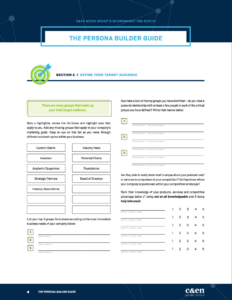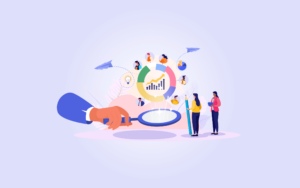In our previous posts from our neuromarketing series, we’ve shared why marketing driven by the needs of your target audience is more effective and has a more lasting impact on the brain. The first step towards maximizing brain impact is defining your target audience. We walked you through how to define your target audience, and now we’re ready to create your marketing personas.
First, here is the golden rule of thumb: The more personalized and targeted your marketing can become the more likely it is to:
- Catch the attention of decision makers scanning for solutions
- Be downloaded and thoroughly examined by those decision makers
- Be retained in the memory of this key audience
The way to create marketing assets that are highly strategic is to take your target audience research and insights to a deeper level – the persona. A persona is the representative of a group that you created based on research, social media metrics, website analytics and direct interviews.
In this blog post we are going to start building your persona framework. Which is the perfect time for us to introduce our Persona Builder Guide.
 We’ve created a downloadable booklet that will guide you through each step you need to take, from identifying your core audience, to conducting interviews with the decision makers you want to reach.
We’ve created a downloadable booklet that will guide you through each step you need to take, from identifying your core audience, to conducting interviews with the decision makers you want to reach.
This guide is meant to accompany our entire series, so you can get started as soon as you like: after reading this blog post, or once you’ve learned everything you need to know about neuromarketing! (Click here to download.)
The Most Powerful Word
Why do personas have the significant marketing impact that they do? Because of the explicit attention on the subject, and how the word YOU captures and holds the interest of the brain. However, it takes more than just peppering your ad copy and headlines with the word YOU to see its effects. It means taking the time to understand what key words, visuals and emotions will also resonate and amplify the YOU-feeling of each group in your target audience. Let’s use these three groups as an example:
- The client persona
- The strategic partner persona
- The investor persona
Each one of these personas are scanning and searching for something specific. The client needs to be convinced that the solution you are offering is the perfect fit to solve their problem. The strategic partner wants to be reassured that working with you is going to help them meet their business objectives. The investor wants certainty that their money – and time – in your company is worthwhile.
A single marketing asset cannot speak effectively to the decision maker in each group. There is no one-size-fits-all approach that engages the brain. In order to stand out you need to personalize your content so that decision makers will remember you and your message.
Strategic Marketing to the Brain
In the field of science marketing there are numerous examples of marketing assets that educate and inform. A simple search online will generate hundreds of white papers, technical bulletins and comparison charts designed to illustrate – using data, graphs and statistics – all the reasons why one product is better than another.
The marketing assets you’ll have a much harder time finding are ones that stand out from the crowd. The ones that would grab the attention of a decision maker scanning their inbox or their social media feed. The marketing asset that would engage and inspire the reader by triggering emotion and telling a compelling story.
Creating personas allows you to identify the overlap between what the decision makers care about and your area of expertise. The Persona Builder Guide we’ve created is to help you enhance your current marketing with neuromarketing insights. You don’t need to complete the hands on activities now, but take a few minutes to read through the guide, particularly Section 3 focused on building your persona framework.
Content has to do more than educate and inform. It needs to engage and inspire. The insights you will collect from your demographic, psychographic and ethnographic research will help you create content that is more personalized and persuasive because it triggers emotion. The insights will help you build a relationship with your audience and show that you took the time to understand them.
Feeling understood has a powerful emotional impact on the brain. You know this from your own personal experiences: the sense of “you get me” forms an instant connection even among new acquaintances. Researchers from Stanford University demonstrated that feeling understood activated neural regions in the brain associated with reward and social connection, while feeling misunderstood activated neural regions associated with negative affect. Both feeling understood, and not feeling understood, activated different components of the mentalizing system.
You want decision makers to land on your website or open your email and feel understood. You want them thinking:
- You understand my needs
- You understand my goals
- You understand my pain
- You understand my frustration
The key to unlocking that powerful positive feeling is through the addition of interview insights.
How to Use Interview Insights
Interviews with the decision makers in your target audience provide a wealth of information. But these interviews are not surveys. They are opportunities for you to listen to the interviewee walk through their decision making process. These interviews are short 15-20 minute calls or face-to-face meetings that give the decision maker a chance to tell their story – their journey to finding a solution to their problem.
In our experience all of these stories share a common path:
The NEED that was triggered by their pains or frustrations
The SEARCH that followed: where and how did they assess products and/or services
The DECISION making process once the search was completed
The CHOICE made in the end: what were the critical deciding variables?
Listening to their stories gives you a whole new level of awareness, which would never come from assumptions or even years spent in the industry. It comes from doing the research and speaking directly with people. When you are ready to start building your persona please read Section 4 of the Persona Builder Guide on how to organize and conduct persona interviews.
When you are outlining whom to interview, be sure to capture decision makers at different stages of their relationship with you. For example, let’s take a look at building a client persona. You would want to conduct interviews with long time clients, new clients, prospective clients and former clients. As we discuss in Section 4 of the Persona Builder Guide, the toughest interviews to get are with prospective and former clients, but with the help of a neutral third party, it can be done.
Our key advice is not to write-off this particular subset: you need to get a 360o perspective on your products and services. This cross-section approach to building a persona will make it more resilient. You will be able to account for all the perceived strengths and weaknesses associated with your company and address them head on in your content.
During the interviews, your role is to listen to them tell their story. Many people find it quite challenging to turn off their inner monologue and truly listen to someone else. Don’t try to predict what will happen or jump ahead with prepared questions. And remember there is no question template you can apply equally across all interviews, because each decision maker you interview will have their own unique story to tell. You need to listen and try to tease out as many details as you can covering the four critical parts of their story:
- Their need that triggered a search
- How they conducted their search
- The steps they went through to narrow down the candidates and make a decision
- Their satisfaction with the deciding variables and their final choice
At the end of the interview phase you will have data in the form of transcribed interviews. In our experience, within four interviews with a defined group (ex: current clients), you start to see a pattern emerge. Common keywords, emotions and critical variables reveal themselves. As you sift and sort the interview data, you uncover the words and phrases to use in your ad copy and emails instead of industry jargon. You will also know how to present your solutions to their pain points without the hard sales pitch.
Creating and implementing personas takes some effort but the time invested pays off. The data and insights that built the persona make it a robust and reliable marketing asset. You will become a respected resource in your industry because of your in-depth knowledge about the decision makers – which in turn gives you a competitive edge.
Your Persona Marketing Strategy
So far in this blog series we have shared with you:
- The basics of neuromarketing
- How to define your target audience
- How to create your marketing persona
In our next post we’ll be looking at how to put your personas to work in a personalized marketing strategy. Questions to get you started on content needs are spread throughout Sections 5 – 7 of the Persona Builder Guide, and our next post will share ideas about marketing assets, repurposing content you’ve already created, and how to build a persona-centered content calendar.



















